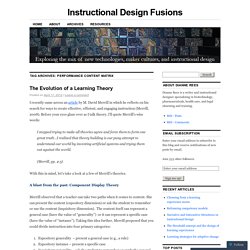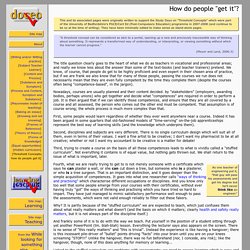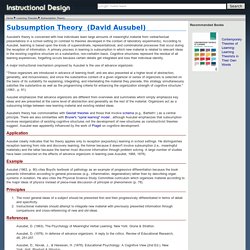

Situated Learning. Lave argues that learning as it normally occurs is a function of the activity, context and culture in which it occurs (i.e., it is situated).

This contrasts with most classroom learning activities which involve knowledge which is abstract and out of context. Social interaction is a critical component of situated learning -- learners become involved in a "community of practice" which embodies certain beliefs and behaviors to be acquired. As the beginner or newcomer moves from the periphery of this community to its center, they become more active and engaged within the culture and hence assume the role of expert or old-timer. Furthermore, situated learning is usually unintentional rather than deliberate. Learning Theory v5 - What are the established learning theories? How to Design Your E-Learning Course Using Gagne’s Nine Events of Instruction. Instructional or Learning Design.
What is known as “sequencing” and organizing “epitomes” in Reigeluth's Elaboration theory, is commonly referred to as “chunking”—configuring large amounts of information into smaller units of information that are scaffolded (supportive structures) in order to accommodate memory and learning limitations.

For example, “Instructional Design” is chunked or epitomized into analysis, design, development, Implementation, & evaluation. Developing instruction (Instructional Design) is divided into several theories and a model (at least on this site). Notice how we took a complex subject and chunked it into small, bite size pieces. Charles Reigeluth was a doctorate student of Merrill. He used a sequencing approach that is consistent with Merrill's Component Display Theory (that is, each theory enhances the other). This zoom lens approach first looks at the subject through a wide-angle lens.
As we continue to zoom, we go into great detail with each iteration or layering. 1. Prechunks. Instructional Design Fusions. I recently came across an article by M.

David Merrill in which he reflects on his search for ways to create effective, efficient, and engaging instruction (Merrill, 2008). Before your eyes glaze over as I talk theory, I’ll quote Merrill’s wise words: I stopped trying to make all theories agree and force them to form one great truth…I realized that theory building is our puny attempt to understand our world by inventing artificial systems and trying them out against the world. (Merrill, pp. 4-5) How to Engage Learners with Scenario-based Learning by Hans Kövi & Kasper Spiro.
“There are numerous ways to design an SBL, and how you design it depends on a number of factors.

The educational level, the learning topic, and of course the available budget are important variables. But no matter how you design scenario-based learning, you can use it for situations that include medical training, sales training, and compliance training.” The demand for scenario based-learning (SBL) is growing rapidly. SBL is now the most requested type of eLearning among our customers. This is part of the trend to use eLearning more and more for skill training and not just for knowledge transfer. In this article, we dive into the theory that explains why SBL can be effective, and we give some guidance on how to develop effective SBL. The Basics of Scenario-Based e-Learning - eLearning Industry. In this post, I will walk you through the various aspects of scenario-based eLearning, so that you can design eLearning courses which not only keep the learners motivated and engaged, but provide them with the best possible educational experience that effectively enhances their skill sets and/or knowledge base.

There are a myriad of instructional design theories and models to choose from when creating eLearning courses. In fact, selecting the one that fits your students’ or employees’ needs can often be a challenging task. However, if you are looking for a model that is ideally suited to improve learner engagement, then scenario-based eLearning may be the solution.Scenario-Based eLearning, essentially, immerses the learners in real life or situational simulations or learning experiences that allow them to gather skills or information that they will recall for future use. Scenario Based Learning - Designing Education Lab. From Designing Education Lab The successful practice of engineering in today’s workplace requires the integration of a broad range of skills that often extend beyond standard engineering curricula.

This involves interpersonal skills such as teamwork, communication and persuasion, and business skills such as entrepreneurship, cost management and marketing. Scenario-based learning (SBL) curriculum has been developed by Sheri Sheppard (as the engineering content expert) and Mark Schar (as the entrepreneurial content expert) and tested for the past three years at Stanford University. The SBL curriculum is designed to support an introductory solid mechanics or statics course.
Teaching & Learning Principles. This learner-centered perspective is a hallmark of the Eberly Center’s approach to teaching.

We strive to empower instructors by helping them develop a deep understanding of how students learn, so that they can effectively apply and adapt teaching strategies to meet their own goals and their students’ needs. The purpose of the following materials is to present current research and theory on student learning in a way that can inform and guide effective teaching practices. Learning Principles This section introduces some key concepts from the cognitive and educational research literatures and presents a concise set of seven principles on how students learn. Teaching Principles. Introduction to Threshold Concepts. This and its associated pages were originally written to support the Study Days on "Threshold Concepts" which were part of the University of Bedfordshire's PGCE/Cert Ed (Post-Compulsory Education) programme in 2007-2008 (and continue to be so at the time of writing).

They have been minimally edited to make sense as stand-alone pages. "A threshold concept can be considered as akin to a portal, opening up a new and previously inaccessible way of thinking about something. It represents a transformed way of understanding, or interpreting, or viewing something without which the learner cannot progress.
" (Meyer and Land, 2006:3) The title question clearly goes to the heart of what we do as teachers in vocational and professional areas; and really we know less about the answer than some of the text-books (and teacher trainers) pretend. First, some people would learn regardless of whether they ever went anywhere near a course. Second, disciplines and subjects are very different. Why? Conclusion. Subsumption Theory. Ausubel's theory is concerned with how individuals learn large amounts of meaningful material from verbal/textual presentations in a school setting (in contrast to theories developed in the context of laboratory experiments).

According to Ausubel, learning is based upon the kinds of superordinate, representational, and combinatorial processes that occur during the reception of information. A primary process in learning is subsumption in which new material is related to relevant ideas in the existing cognitive structure on a substantive, non-verbatim basis. Learning_theories:assimilation_theory [Learning Theories] General What is assimilation theory?
![learning_theories:assimilation_theory [Learning Theories]](http://cdn.pearltrees.com/s/pic/th/learning-theories-assimilation-108999928)
Learning, according to Ausubel's theory, occurs through development of new cognitive structures that will hold newly acquired information. Cognitive structure, a central term in his theory is defined as the.